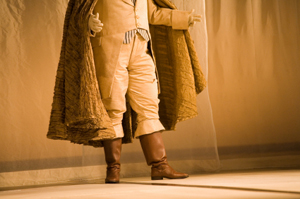 Despite the many adventures, sonic and otherwise, offered by the Grammy’s on Sunday night, I think it was specifically a reference to the performance by “Italian opera star” Andrea Bocelli that truly had my hand smacking my forehead. It wasn’t just that “classical music” was hidden away from the prime time audience (which, if you check out the numbers, would be somewhat hard to argue with), but that the field was actually being painted over with something else entirely while everyone was looking.
Despite the many adventures, sonic and otherwise, offered by the Grammy’s on Sunday night, I think it was specifically a reference to the performance by “Italian opera star” Andrea Bocelli that truly had my hand smacking my forehead. It wasn’t just that “classical music” was hidden away from the prime time audience (which, if you check out the numbers, would be somewhat hard to argue with), but that the field was actually being painted over with something else entirely while everyone was looking.
On Monday morning reflection, it seemed like the intonation disasters and unfortunate genre collisions were obvious to fans of all persuasions. But it drove home an issue that seems to be much on the minds of performing arts administrators across the land as they consider the numerous studies released of late covering the health of the field: what are we really talking about when we talk about “the arts and culture” in America? Opera performances and symphony orchestra concerts? Does jazz, which is, after all, “America’s classical music,” count, or is there not enough gold leaf in those venues? The NEA tacked on “Latin, Spanish, or salsa music” to their arts participation study in 2008. The Americans for the Arts National Arts Index included figures for “Attendance at Live Popular Music” but the majority of the report seemed squarely focused on the more traditional non-profit institutions and the constituencies they serve. Perhaps most tellingly, when the Fine Arts Fund in Cincinnati conducted their research, they found that the survey participants (“average Cincinnatians”) did not define “the arts” or “culture” in the same way that the field’s insiders used these same terms. “Arts could be things like roller-skating, if you do it that way,” said a 49-year-old man. Interpretive roller derby, anyone?
So as we motivate our way every day towards a more “democratic” creative culture, lowering the hurdle to participation through slick software and communications technology, will we need to shift our definitions and lose the death grip we have long held on the European derived “high arts” or do we need to clamp down even harder or risk being washed away in the muddle? Can we shake ourselves awake and figure out how we want to connect with our communities before we slip further from American consciousness? Reviewing these arts reports and considering the Grammy performances, I can see why a little rain cloud might feel like it’s hovering over American culture at the moment, but on reflection I considered all the art being created that also didn’t see the light of day on CBS that night, and suggest that it’s not quite a Rome Before the Fall scenario. Maybe, actually, we can look at the Grammy train wreck as an indication that the Billboard charters are the ones on that path, and with some planning, perhaps we can capture new ears desperate for something better.
Related: The mom sitting across the aisle from me on this Amtrak train is telling her friend all about how heartwarming it was to see that “creepy weird girl” perform with Elton, so you know, there’s also that. Watch out, Michael Buble. She’s coming for you!

i like this post. I guess I feel like the biggest thing dividing “art” music from “commercial” music are their contrasting socioeconomic circuits. The more research I do, the more I see sociomusical (both sound and people) overlap between certain kinds of musics (e.g.new music with electronica). But the non-profit/for profit divide remains. What would happen if art music took on a more for profit economic form? What would that sound like? longer versions of Radiohead?
btw why does the Grammys pair musicians in such a goofy way? I also get the impression that it’s hard for musicians to hear themselves on stage at that thing. Intonation mistakes seem so rampant, and a lot of those people are really great.
Molly adds: Indeed, would it all just be…better, with the drive, or restrictive with the risk? Also, yes, that venue was huge. I can only imagine what “hearing” was like in those circumstances. No fun is probably the short version.
I think arguing in an apparently exclusionary and even undemocratic way about the meanings of terms like “art” and “Italian opera star” is probably not an efficient way to make our case. To put it another way, you could probably convince a Bocelli fan that Andrea’s not really a “star” of “Italian opera” by collecting data on his lifetime ratio of crossover albums to actual opera productions. However, even if you played this Bocelli fan Tito Schipa record after Tito Schipa record until you were blue in the face, you might never convince him that Schipa was the better singer, and it’s difficult to muster a rational and concise argument to support that point of view in conversation with an opera neophyte.
Molly adds: I actually did this experiment! I got a Juan Diego Flórez CD for my mom to compliment her love of Bocelli. She gave it a go a few times, but it was moved pretty quickly to the bottom of the pile. Bocelli is still in regular car stereo rotation, however. He connects in a way Juan Diego just isn’t ever going to, it seems. It was a big lesson for me.